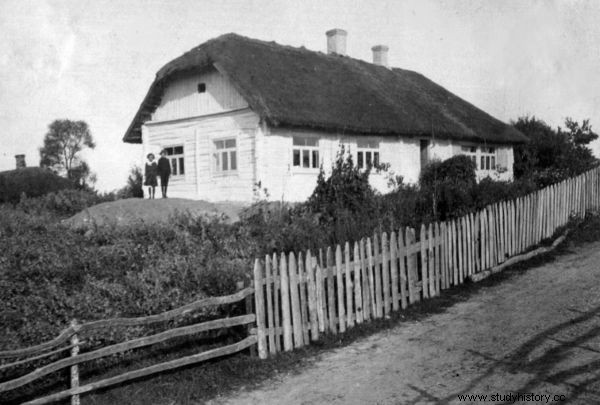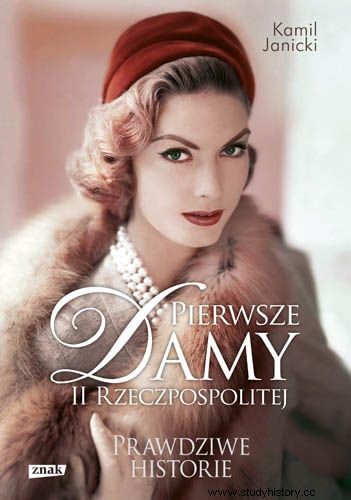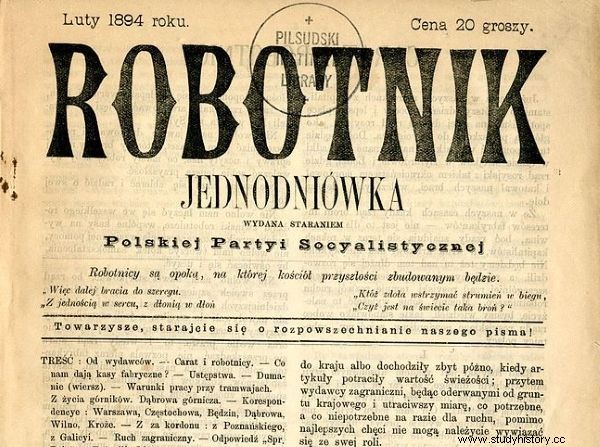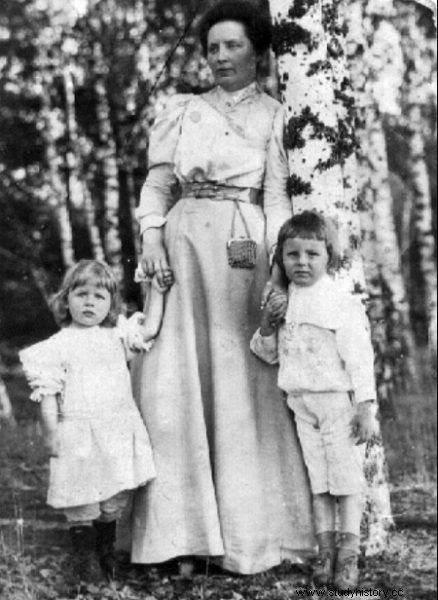Nerves of steel, maniacal stubbornness and unwavering faith in the greater thing. In 1922, Maria becomes the first lady. But already in her youth she proved that she can take on much more than just salon duties.
It is 1894. Maria Kiersnowska is less than 24 years old - she was born on December 15, 1869. She is a tall brown-haired woman with clear, even aggressive facial features, an intriguing smile and deep-set eyes. Maybe not every man you meet does not look after her, but you cannot deny her beauty. All the more, she does not lack sophistication, knowledge and intelligence.
A well-behaved young lady
She recently graduated from the Mariinsky Institute in Vilnius. Her daughter-in-law, Izasława Wojciechowska, proudly recalled years later:" Women in those days could not achieve higher education. Only a few began to study at the University.
Professor Maciej Grabski is equally flattering about his grandmother's youth:“she was a well-educated, well-bred young lady”. Her father, Antoni Kiersnowski, had some property in Lithuania (two villages near Giedrojć), so Maria was a really good party. A perfect wife for the ranks of impoverished nobles living in the area. Except that Marysia, neither men, nor home and family, were in her mind so far.

Kiersnowski manor house in Kupryszki. Photo from 1914.
A noblewoman with ambitions
The girl did not want to change diapers, but to fight for a bigger cause. Such an impulse did not surprise anyone. In her family, ideas were always high on the agenda. Maria's grandfather, Jan Kiersnowski, was exiled to Siberia for taking part in the November Uprising. Her uncle, Father Stanisław Iszora, was shot in one of the main squares of Vilnius for inciting parishioners to take part in the January Uprising.
Throughout her childhood, Marysia listened to stories about heroic ancestors and uprisings in which she did not have the opportunity to participate only because she was born two or three decades too late. One thing she knew for sure:another insurrection would not pass her nose anymore!
When Maria Paszkowska, a tutor from school days, nicknamed "Gintra", offered Marysia to participate in an independence organization, she did not need time to think. This does not mean, however, that her decision was approved by her parents. Fighting for independence? A good cause, without a doubt. Only that Marysia - this well-mannered lady from a small-foreign family - decided to pursue it in ... the Polish Socialist Party. Fighting for workers' rights and a new and better system.

Get to know the profiles of extraordinary women who stood alongside the presidents of pre-war Poland. The article is based on the book by Kamil Janicki entitled "The First Ladies of the Second Polish Republic."
Kiersnowska's cold blood
It is difficult to say when exactly the Vilnius PPS recruited the young Kiersnowska. She herself recalled it briefly:"Gintra (Paszkowska) accepted me to work in the party, who gave us tutoring". It is known about Maria Paszkowska that she joined the party in 1893. She was given a mission to build a group of couriers and distributors of the underground PPS organ:"Robotnik". The first issue of the newspaper appeared in 1894, so it can be assumed that around that time Marysia joined the ranks of the party.
She was energetic, discreet, firm and - probably the most important thing in this profession - she was able to keep a cool head. When others fell into the hands of spies and landed in tsarist prisons, she skillfully escaped the attention of the police. Gradually she climbed the ranks of the underground career. Initially, it only distributed "blotting paper", that is, illegal newspapers and socialist proclamations.

Activists of the Polish Socialist Party. Only men in the photo, but this does not mean that the PPS lacked heroic women ...
At this stage, she mainly contacted Paszkowska herself. She quickly began to cooperate with the local PPS top. First of all, with a slightly older correspondent of the conspiratorial 'Przedświt', who has just joined the top leadership of the party. The boy's name was Józef, his last name was Piłsudski, and he was just starting to grow his famous mustache.
Piłsudski's cutlets
Their first closer encounter, as far as we know, was not particularly successful. Or rather, Marysia, who had books and ideas in her head, not cooking, did not turn out to be the best hostess.
In her old age, she said:“Once, in Vilnius, I met Piłsudski. He said he had a few rallies, but he did not know where he was going to spend the night because they were following their friends' apartment. The young conspirator immediately saw an opportunity to prove herself to the above-mentioned colleague:“I invited him to my place. He accepted the invitation with joy, but warned that he would come hungry and tired. ”
The hunger needed to be satisfied, and the energetic socialist ... was clearly unable to cope with it:“ When Piłsudski came, I started cooking him a meal, but I couldn't. The cutlet was falling apart. Piłsudski said that eggs should be hammered into the meat ”. Culinary advice provided by the future Chief of State did not help much. Instead of the cutlet, a watered-down slush came out, and the starving guest was forced to eat "this kind of porridge".
Conspiratorial work requires sacrifice. You know. Despite unpleasant experiences, Piłsudski visited Marysia more than once. It can be assumed that on more than one occasion he has tasted her chops, and more. Anyway, Kiersnowska became a really good hostess over time. Maybe there was some contribution from the Marshal in this?
A cousin with a mustache
Other visits also appear in Maria's memoirs written by her son-in-law. Kiersnowska and Piłsudski met not only in Vilnius, but also in the capital of the Vistula Krai:“Once in Warsaw, where I was staying at a guesthouse with a family, I met Piłsudski. He invited himself to visit me, not wanting to be on the streets during the day. In order to avoid rumors, I told my hosts that my cousin had come to visit me from Vilnius, whom I had invited for dinner ”.

One of the first issues of Robotnik. Maria Kiersnowska had considerable merits in the printing and dissemination of this magazine.
The explanation apparently amused Piłsudski, because from then on he constantly called Marysia his cousin. Slowly their camaraderie turned into something more. Various authors claimed that Maria Kiersnowska was Piłsudski's friend. And I guess we have to admit that they are right. But never had their relationship taken on a different character:Maria was attracted to revolutionaries, but she was already watching over someone else. Besides, this young idealist required a lot of men.
Cowardly Governor
Piłsudski could, of course, be charming, and he wielded words like a sword, but the future president also appreciated courage. In her opinion, Józef lost by forfeit in this field. Unfortunately, the details of the story, which Maria liked to recall, have not survived.
She knew what discretion was, so she only told her closest family about the infamous episode in the life of the future Legion commander. Her grandson Maciej Grabski remembered:
She took Piłsudski somewhere as a courier, not across the border, but somewhere as a courier. They stumbled upon a Russian patrol, and he was terribly scared. Grandma didn't know what to do with it. Then she said that Ziuk is a coward. Awful coward!

Maria Kiersnowska (and then Wojciechowska) with children in the photo from 1908.
Kiersnowska's words gain weight when we realize that this woman perfectly understood the meaning of courage. It wasn't an empty word for her. She has proven many times that she can cope with the most stressful situations.
She smuggled a heavy printing press across the border and led her out into the field of tsarist spies who would be on her heels for hours on end. Her attitude turned the head of one of the founders of the Polish Socialist Party:the future president of Poland, Stanisław Wojciechowski. However, these are all topics for a separate article. Or a whole book, actually.
Source:
The article was based on materials collected by the author during the work on the publication "First ladies of the Second Republic of Poland" (Wydawnictwo Znak, 2012) . The family illustrations come from the collection of Maciej Grabski, made available for the book.
